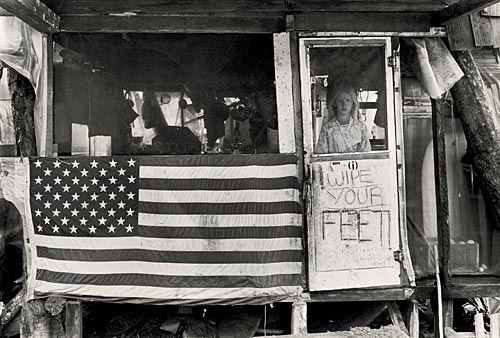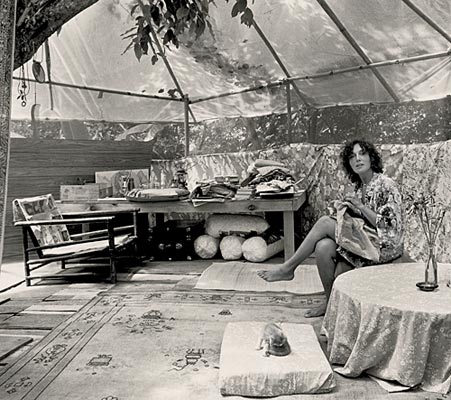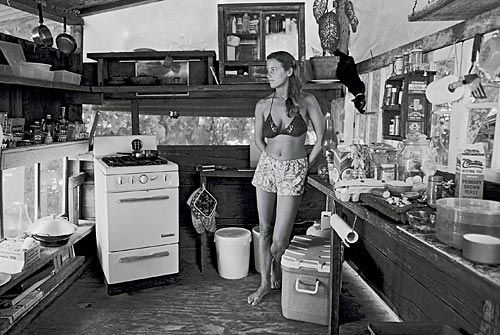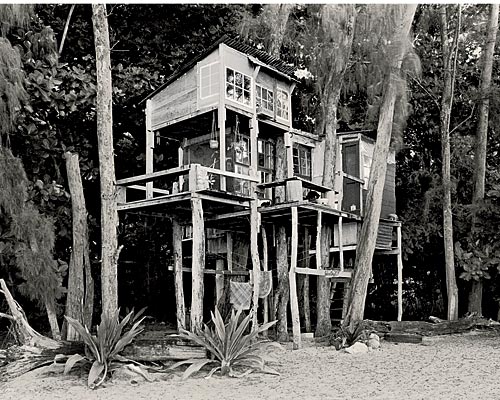Precious paradise

Alpin Hamilton stands behind the front door of her parents' home in Taylor Camp, a remote hippie commune that existed on Kauai's North Shore in the 1960s. She was only 3 when her family moved to the camp.

Francine Pearson embroiders in her treehouse dwelling.

Richie Palumbo and Diane Patalano sit in their treehouse dwelling in Taylor Camp, on the North Shore of Kauai, in the 1960s.

Diane Stiegel, above in her kitchen, lived in a tree house made from material taken from an old plantation house that was going to be torn down.

Stiegel's tree house.

Taylor Camp had several faiths. Here members participate in an om circle in the Church of the Brotherhood of the Paradise Children.






In 1971, when he was 23, John Wehrheim found himself living with friends in Haena, a remote community on Kauai’s North Shore where the beauty was unparalleled: an unspoiled jungle giving way to a crystalline blue bay.
But Wehrheim, a photographer and writer from Chicago, found something more precious than paradise. He found Taylor Camp.
SHOWING"Taylor Camp" will be screened at 7 p.m. tomorrow at Bambu 2.0, 1144 Bethel St. Tickets are $10. Doors open at 6:30 p.m. For more information, call 223-0130. |
The camp was a 7-acre community of hippies who lived naked on the land – anti-establishment dropouts, troubled Vietnam War veterans and eager surfers.
Instinctively, Wehrheim did what he knew best. He started taking photographs.
Don't miss out on what's happening!
Stay in touch with breaking news, as it happens, conveniently in your email inbox. It's FREE!
Now, almost four decades later, Wehrheim’s black-and-white images are the heart of a documentary about a bygone era. "Taylor Camp" is an unflinching flashback to a time of 1960s innocence and clashing cultural values that mixes photos, film and interviews with former residents and their neighbors.
Wehrheim produced "Taylor Camp" along with Thomas Vendetti. Robert C. Stone directed it. They started the project in 2006 and watched it grow from a slide show to a film that was screened and revised 10 times over the past 18 months. The final 89-minute version was shown in May at the Hawaii Theatre, and the film is being screened again tomorrow night at Bambu 2.0 in downtown Honolulu.
"I always wanted to tell the story of Kauai and use Taylor Camp as a vehicle," said Wehrheim, now 62. "I wanted to capture the sweet, innocent feeling of what Kauai was like in the ’60s and ’70s. It’s hard for people to imagine that time."
 |
| John Wehrheim |
Wehrheim, who made Kauai his permanent home, insists the film does not unduly romanticize the camp.
Taylor Camp was a complex place that angered many on Kauai. Its "dark side" included violent conflicts with area neighbors and substance abuse among residents. The treehouse homes built by the campers were viewed as an eyesore by local officials who fielded complaints about thefts, unsanitary conditions, drugs and open nudity.
When the county evicted the residents in 1977, authorities set fire to the camp to ensure they wouldn’t return.
Taylor Camp was started in 1969 by 13 people who had fled campus riots and police brutality on the mainland. Police arrested them for vagrancy, but Kauai resident Howard Taylor – brother of actress Elizabeth Taylor – not only bailed them out, he let them live rent-free on his vacant property at Haena.
Word of the camp spread fast. Some called it a hippie fantasy. Surfers saw it as an extended surfari. Vets saw it as an emotional refuge. About 120 people lived there at its peak.
"I think most of them were looking for a timeout, an escape, for a place where they could enjoy time, where time wasn’t expensive," Wehrheim said. "You could live your life without much pressure."
The film’s recent origins had nothing to do with making a documentary.
Wehrheim had approached Vendetti and Stone, with whom he had worked on a film about Bhutan, to see whether they could help him digitize his collection of Taylor Camp photos. Wehrheim had wanted to make it easier to give out photographs to the many former campers who wanted copies.
When Stone saw the photos, he was moved. Although Wehrheim had taken hundreds, his best were done in the camp’s final year. They documented a society in full bloom, and Taylor Camp residents seemed to glow in each portrait Wehrheim took.
"They were very realistic, and there seemed to be an honesty to them," Stone said.
Their first version of the film was actually a 15-minute slide show that drew about 1,000 people to a theater with 300 seats. Afterward, former Taylor Camp residents approached the filmmakers to share their personal experiences, Stone said.
That gave rise to a series of potluck reunions where the filmmakers put the campers in front of a camera, said Stone, a 55-year-old Maui resident who has made videos for the last 35 years.
"I would say about 97 percent of the people said this was the best time of their lives," he said. "I think there was that sense of freedom and youth and vitality and living with nature and community that just makes an impact on a young person’s life."
David Pearson felt exactly that. In fact, he still feels that way. A surfer, Pearson had spent nearly a decade in Hawaii by the time he landed at Taylor Camp in 1972.
"If I could go back, I would go back this second," said Pearson, now a 67-year-old retired public school teacher on the Big Island. "I can’t imagine anything more pristine and beautiful than the life I had there."
Pearson met his second wife there. Francine Pearson had worked on the East Coast running a lobbying group when she took a vacation to Kauai in March 1976.
She couldn’t believe the beauty she found at Haena and the openness of the community in the camp. Strangers took her in.
"It seemed to be a message from the universe," she said.
When she told her family about her decision to stay and the reasons why, they thought she had been kidnapped by a cult.
"It was the single most defining experience of my life," said Pearson, now 67 and also a retired public school teacher.
"It changed me in ways that are evolutionary. The whole idea of being a part of nature rather than outside of it, and having to tame it, is enormous. I became a spiritual person."
From the very beginning, Wehrheim was conscious of the way Taylor Camp changed people, especially those running from problems.
"I think anyone who arrived at Taylor Camp and went through the magical alchemy of being accepted, they felt they were home," he said. "There was mana there. There was the power to heal."



